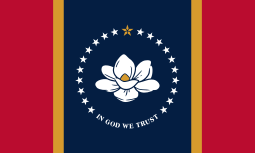Flag of Mississippi
 |
|
| Use | Civil and state flag |
|---|---|
| Proportion | 2:3 |
| Adopted | April 23, 1894 |
| Design | Three horizontal stripes of blue, white, and red. The canton is square, spans two stripes, consists of a red background with a blue saltire, bordered with white, and emblazoned with thirteen (13) five-pointed stars. |
The flag of the state of Mississippi was first adopted by the U.S. state of Mississippi in April 1894, replacing the flag that had been adopted in 1861. The flag was subsequently repealed in 1906 but remained in de facto use. When a referendum failed for a new design in April 2001, the state legislature voted to readopt the historic design that same month. Since Georgia adopted a new state flag in 2001, the Mississippi flag is the only U.S. state flag to include the Confederate battle flag's saltire.
In 2001 a survey conducted by the North American Vexillological Association (NAVA) placed Mississippi's flag 22nd in design quality of the 72 Canadian provincial, U.S. state, and U.S. territorial flags ranked.
The pledge to the state flag is:
I salute the flag of Mississippi and the sovereign state for which it stands with pride in her history and achievements and with confidence in her future under the guidance of Almighty God.
The statute is part of the set of state statutes that governs the curriculum of the state's public schools. Section 37-13-7 provides: "The pledge of allegiance to the Mississippi flag shall be taught in the public schools of this state, along with the pledge of allegiance to the United States flag."
Prior to 1861 Mississippi, like most U.S. states, had no official state flag. When Mississippi declared its secession from the Union on January 9, 1861, near the start of the American Civil War, spectators in the balcony handed a Bonnie Blue Flag down to the Secession Convention delegates on the floor, and one was raised over the capitol building in Jackson as a sign of independence. Later that night residents of Jackson paraded through the streets under the banner. Harry McCarthy, a singer and playwright who observed the parade, was inspired to write "The Bonnie Blue Flag", which, after "Dixie", was the most popular song in the Confederacy.
...
Wikipedia
